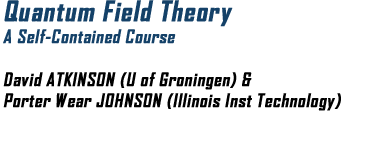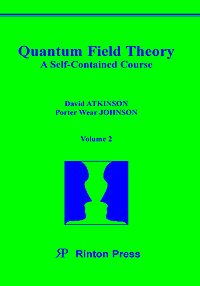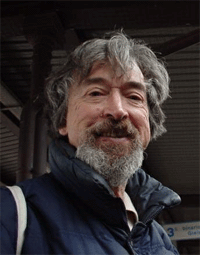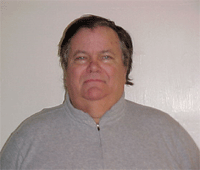| |

|
 |
|
 |
216 pages, 9x6 inches
Oct
2002 Hardcover
ISBN 1-58949-024-X
US$48 |
|
|
|
Buy It |
|
|
 
The only prerequisites for this book are
a knowledge of partial differential equations, Maxwell’s
theory of electromagnetism, and the material of Volume
1. An introduction is given to the special theory of
relativity, to the relativistic reformulation of
Maxwell’s equations, and also to unbounded operators on
Hilbert space. The basic goal is the setting up of rules
for drawing Feynman graphs and for calculating
amplitudes from them. This is done primarily in quantum
electrodynamics; but an appendix sketches the extension
to the electroweak theory, and Feynman rules are given
for this extended Lagrangian. Each chapter is
complemented by ten problems, and the student is advised
to try them all by himself or herself before looking at
our solutions in Volume 4.

undergraduate students, graduate students, teachers, researchers interested in modern physics. |

1. Relativity and Quantization
Unbounded Operators
on Hilbert Space
Rigged Hilbert Spaces and Operator Algebra
Special Theory of Relativity
Schrödinger and Klein-Gordon Equations
Dirac Equation
Dirac's Views
Exercises
2. Charged Particle in Electromagnetic Field
Maxwell's Equations
Covariant Derivative
Pauli Equation
Spin-Orbit Coupling
Atomic Physics
Exercises
3. Dirac Hydrogen Atom
Scalar Central Potential
Solution of Dirac Equation
Bound-State Formula
Dirac Spinors
Particle and Spin Projection Operators
Exercises
4. Quantum Field Theory
Scalar Field
Electromagnetic Field
Spinor Field
Exercises
5. Group Theory and the Noether Theorem
Rotation Group and SU(2)
Poincaré group and SL(2,C)
Noether Theorem
Parity, Time Reversal and Charge Conjugation
Exercises |
6. Scattering Theory and Feynman Graphs
Asymptotic Fields
LSZ Reduction
Wick's Theorem
Diagrams in Momentum Space
Exercises
7. Quantum Electrodynamics
LSZ Formalism for QED
Compton Scattering
Mřller Scattering
Photon-photon Scattering
Exercises
8. Dimensional Regularization
Rationale for the Method Scattering Theory
Fermion Self-Energy
Vacuum Polarization
Cutkosky Rule
Magnetic Moment and g-Factor of Electron
Exercises
9. Dyson-Schwinger Equations
Vertex Function
Dyson-Schwinger Equations
Ward-Takahashi Identity
Chiral Symmetry Breaking in Strong QED
Exercises
Appendix
Electroweak Interactions
Spontaneous Symmetry Breaking
Leptonic Sector
Quark Sector
Experimental Tests
Exercises |
|

 David
ATKINSON
received his Ph.D., under Hamilton, from
Cambridge University in 1964, and has been a
professor of theoretical physics at
U of Groningen
since 1972. He worked as a visiting scientist at
CERN, UC Berkeley, Rome University, Bonn
University, Imperial College, Tata Inst.,
University of Canberra, Yukawa Inst, etc. Dr.
Atkinson is well known partly for his excellent
and solid research works on the strong
interaction S-matrix theory, the mathematical
and numerical study of phase-shift analysis, the
Dyson Schwinger equations, both in QED and QCD,
and the quark propagator equations and chiral
symmetry breaking. He has published over 100
research papers in the well-known journals. His
recent interest is in the problem of
interpretation in probability theory and quantum
mechanics. Prof. Atkinson has been teaching
quantum mechanics and quantum field theory for
many years. David
ATKINSON
received his Ph.D., under Hamilton, from
Cambridge University in 1964, and has been a
professor of theoretical physics at
U of Groningen
since 1972. He worked as a visiting scientist at
CERN, UC Berkeley, Rome University, Bonn
University, Imperial College, Tata Inst.,
University of Canberra, Yukawa Inst, etc. Dr.
Atkinson is well known partly for his excellent
and solid research works on the strong
interaction S-matrix theory, the mathematical
and numerical study of phase-shift analysis, the
Dyson Schwinger equations, both in QED and QCD,
and the quark propagator equations and chiral
symmetry breaking. He has published over 100
research papers in the well-known journals. His
recent interest is in the problem of
interpretation in probability theory and quantum
mechanics. Prof. Atkinson has been teaching
quantum mechanics and quantum field theory for
many years. |
 Porter
Wear JOHNSON
received his Ph.D. from Princeton University in
1967. He has been a professor of physics at the
Illinois Institute of Technology (IIT) since
1983. Dr Johnson has been the director of
Science and Mathematics Initiative for Learning
Enhancement (SMILE) Program at IIT since 1993
and the director of Science and Mathematics
through Application of Relevant Technology
(SMART) program since 2000. His recent research
interests in high energy theoretical physics
involve dynamical mass generation in formally
massless quantum field theories, including a
number of studies of fermion mass generation in
three and four dimensions. The interest lies in
QED in its own right, as well as in other
theories for which the effective coupling
strength varies quite slowly with changing
momentum scale. Dr Johnson has also studied the
problem of Chiral Symmetry Breaking in Quantum
Chromodynamics, with the goal of understanding
low energy hadron phenomenology in the context
of these models. Porter
Wear JOHNSON
received his Ph.D. from Princeton University in
1967. He has been a professor of physics at the
Illinois Institute of Technology (IIT) since
1983. Dr Johnson has been the director of
Science and Mathematics Initiative for Learning
Enhancement (SMILE) Program at IIT since 1993
and the director of Science and Mathematics
through Application of Relevant Technology
(SMART) program since 2000. His recent research
interests in high energy theoretical physics
involve dynamical mass generation in formally
massless quantum field theories, including a
number of studies of fermion mass generation in
three and four dimensions. The interest lies in
QED in its own right, as well as in other
theories for which the effective coupling
strength varies quite slowly with changing
momentum scale. Dr Johnson has also studied the
problem of Chiral Symmetry Breaking in Quantum
Chromodynamics, with the goal of understanding
low energy hadron phenomenology in the context
of these models. |
|
|
|
|

